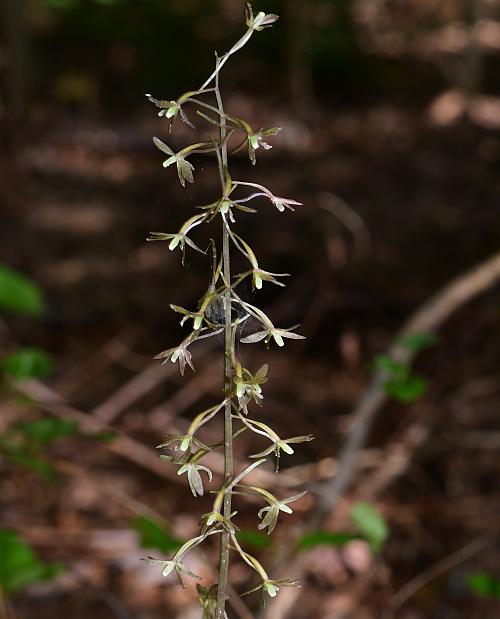Tipularia discolor (Pursh) Nutt.
Cranefly Orchid

Native
CC = 10
CW = 3
MOC = 7
© SRTurner
Tipularia discolor (Pursh) Nutt.Cranefly Orchid | |
 |
Native CC = 10 CW = 3 MOC = 7 |
© SRTurner |
|
Family - Orchidaceae Habit - Perennial forb with 2 or 3 ovoid, tuberous corms, these usually connected by short rhizomes. Stems - Flowering stem erect, to 60 cm, greenish-brown, glabrous. Leaves - Basal leaf 1, from the terminal corm, the petiole to 4 cm long, the leaf blade 5-10 cm long, ovate-triangular to heart-shaped, glabrous, herbaceous, and often somewhat pleated, entire (the margins often sinuous), dark green above (sometimes with slightly expressed purple spots), purple beneath. Stem leaves reduced to a few sheathing bracts.
Inflorescence - Terminal raceme to 30 cm tall, bearing 20-40 flowers. Pedicels spreading, to 8 mm long, glabrous, each flower subtended by a minute scale-like bract. Bracts maroon, 0.1 mm long (use a lens to see).
Flowers - Sepals and lateral petals each 3, similar, positioned asymmetrically with 1 petal overlapping the uppermost sepal, 4-8 mm long, narrowly oblanceolate, greenish purple. Lip 4-8 mm long, 3-lobed, the middle lobe linear with 2 small notches at the tip, pale purple. Spur 15-22 mm. Column 3-4 mm long, white. Stamen 1, staminodes lacking. Ovary inferior, 6-7 mm long in flower, glabrous, greenish-brown.
Fruits - Pendent capsules, 10-12 mm long, elliptic in outline, not strongly ribbed.
Flowering - July - August. Habitat - Moist soil of mesic forests, stream terraces, tops of shallow sand dunes. Origin - Native to the U.S. Lookalikes - Broadly, several other orchids. Other info. - T. discolor is a relatively new species to Missouri, reported from the state for the first time in the 1980s. Though currently uncommon in Missouri, it is believed to be expanding its range in the U.S. and the Missouri population may be part of this expansion. At present the plant can only be found in the extreme southeastern corner of the state, with its range extending from there south and east to the respective coasts. It is easy to ID in the field because of its distinctive leaves (which appear in the fall, overwinter, and then wilt at anthesis) and its plain-colored inflorescences, which appear in the summer.
Photographs taken in Brown Summit, NC., 7-6-02 and 10-20-02 (DETenaglia); also at Holly Ridge Conservation Area, Stoddard County, MO, 8-16-2021 (SRTurner) |